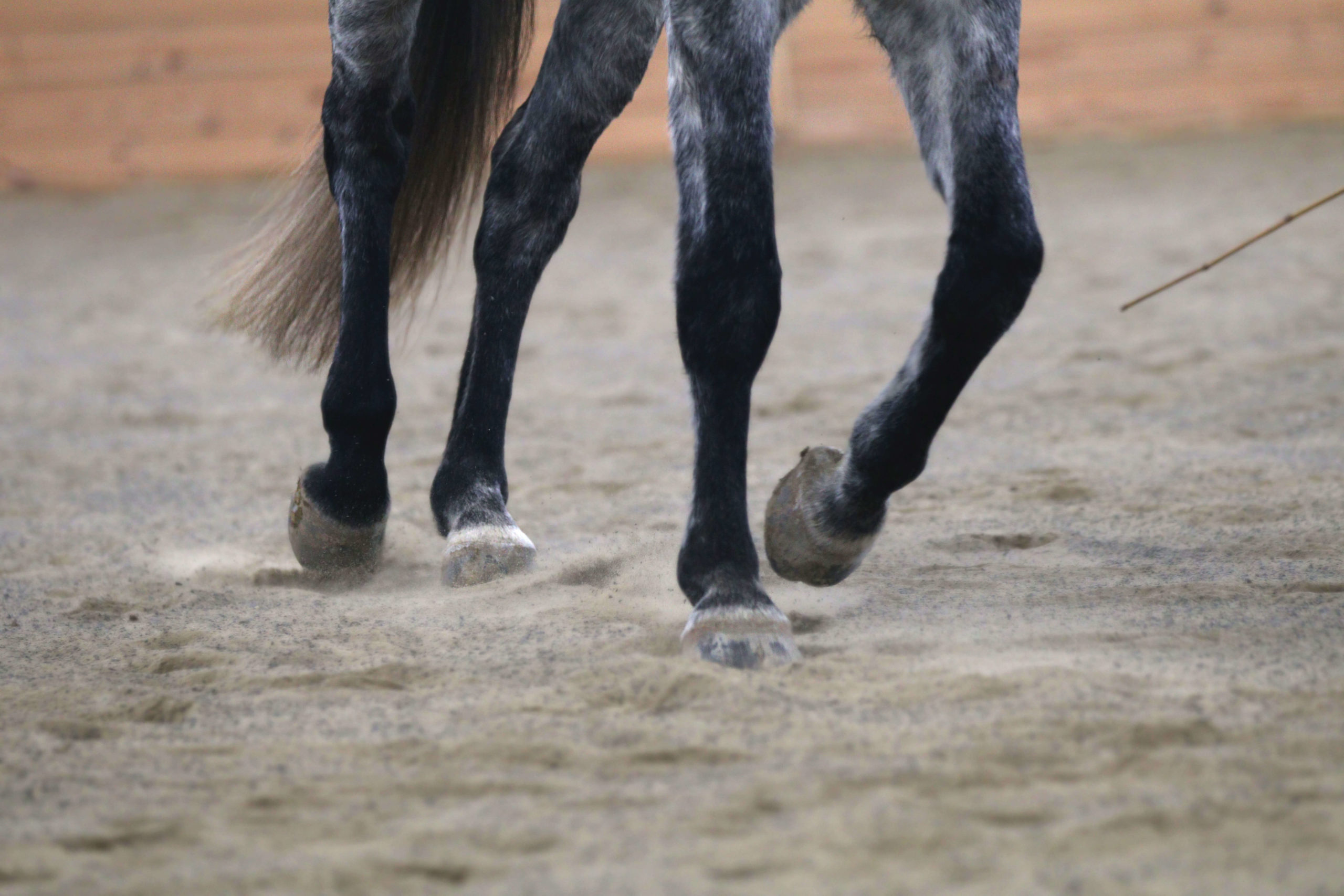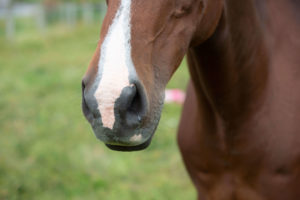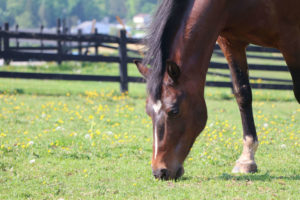I have received quite a few questions lately regarding difficulties with picking up and cleaning out horses hooves. In my experience teaching new riders, this is an unnerving chore for many people, as well as a skill that requires trust and training on the part of the horse. So don’t worry if you are having some issues here too! In the paragraphs ahead, I will go over some common problems and the best ways to fix them.
First we will start with the proper technique for the handler. When picking up your horse’s hoof, stand facing back towards his tail. Keep your feet pointed back and standing beside the horse, not underneath him. Keep your head up and be aware, so that if he makes a sudden move during the process you do not get hurt. Run the hand closest to the horse down his leg and squeeze right above the pastern joint. The cue to lift a foot is different for some horses, so you can also try squeezing the chestnut, pulling the feathers, or tapping the leg. If your horse still will not lift his foot, lean into his shoulder or haunch to push his weight onto the opposite leg, and get a little more demanding with your squeezing. When your horse does pick up his leg immediately grasp his hoof – do not try to hand onto his leg or his pastern, horses hate this. Holding the foot lower is more comfortable for the horse, however if he starts trying to pull it away, lift the leg straight up, it is much more difficult for the horse to pull his foot away in this lifted position.
So next, how to train your horse to pick up his feet. Young horses do not like having their legs lifted and hooves picked because one- you are a predator hanging onto their leg, and two-it is not comfortable for them to stand on three legs. Older horses may have been accustomed to hoof picking but then had a bad experience with a farrier and are now scared of the process. Either way, the technique to train them to pick up their feet quietly is almost the same. Start by making sure that the horse is calm to start off – spend some time grooming so that he is relaxed and has developed some trust for you. Next, see if you can run your hands down his legs without him getting nervous or moving around. If he does get nervous at this first step, stop here and spend time just petting his legs until he stands quietly. When you are ready to pick up the leg start with a squeeze or a tap above the fetlock. As soon as he picks up his foot, grasp the hoof, hold it only a few seconds, then release it and praise him profusely. Next time hold it a little longer, still trying to release before he starts fighting. If he does try to pull it away, lift the leg and hang on as best you can, but don’t get hurt. If he gets it away from you just start again. With a difficult horse, I don’t even bother trying to clean the foot. Just work on lifting and holding, then clean it when you are both more comfortable. The key here is slow and steady, increase the time the leg is in the air and use lots of praise.
One other note on horses that have had bad farrier experiences – I have found that many of these horses only react when you put the hoof between your legs, like a farrier does when he is working so that both hands are available to work on the hoof and the shoe. The best way to desensitize for this is to hold your horse’s feet in this way each time you clean them. However, this position puts you under the horse and in harm’s way, be very careful and aware anytime that you hold the hoof in this way.
If you have a hoof issue that I didn’t cover, or need further explanation on anything in this post, just leave a comment!














13 Responses
Hi Callie, I’ve just read through this article and there’s one more question: what if getting up the hooves and cleaning them isn’t the problem but the fact that my horse always does some misbehaviour after I’m done cleaning – especially the front legs. I finish cleaning, saying something like “well done” and trying to softly put the hoof down, but he quickly pulls it up and then puts it down like stomping… always short from stepping on my feet. Any idea how to solve this? Thanks a lot!
Hi Jesse,
I would practice picking up the feet and putting them down a lot, without even cleaning them. I would also avoid saying the well done because this may have become a cue for your horse that the process is over. Make it unpredictable when you are going to allow his foot down and be aware so that if you start letting it go down and he gives it a yank you can hang on, softening and allowing it down again when he is still.
Hope this helps! Callie
Hi Callie,
Our well intentioned, trusted, and very experienced barn farrier says sincerely that my horse is the hardest to work with. According to him the antics include pulling, pushing, leaning, moving about and head tossing.
I am in charge of handling Toby. Upon his inevitable movements, the techniques suggested include yanking his lead the second his withers twitch and yelling at him to stop it! Of course my timing is off and is combined with the fact that I totally disagree with these popular methods which obviously do not work. I am a reluctant and ineffectual participant. And I swear Toby looks at me with disbelief!
The twitch was mentioned, is there a way to use this method humanly and effectively? I fear that the impatience of our abused farrier may ramp up if there is no improvement in Toby’s behavior.
(It was even suggested that my clicker training Toby to lift his front legs is causing him to misbehave).
I want to extinguish this behavior for many obvious reasons. Most of all I need Toby to understand this is a routine, safe and reasonable request.
I do not want another person “handling” Toby because I am not tough enough!
Can you suggest methods, reading materials, videos etc., to teach me to show Toby he has nothing to fear. I realize this should be broken down into several steps and sessions. But as you know, hoof care is a frequent necessity. I need swift, savvy, and soothing successes.
Thanks for all you do,
Marion
Hi Marion, thanks for your comment, I apologize I didn’t see it sooner!
I believe you are on the right path with the clicker training. I went through this whole process with a young mare who had never had her feet handled at all, you can see a short version of it here: https://crktrainingblog.com/horse-training/from-dodging-kicks-to-the-first-ride-working-with-zelli/
Using a twitch can be ok when needed – it releases neurotransmitters very similar to common sedatives used for horses. The key is that it is applied quickly and efficiently. But while the twitch may allow you to get the job done it won’t help with making it any better the next time.
Let me know if the above video helps, I honestly don’t remember how much hoof handling there is in this edited version, we do have the full sessions in the program. I do really like helping with these kind of problems
Callie, thanks so much, and forgive my delayed response. I am immersed in information regarding my “Don’t Shoot The Farrier” dilemma. Other than you I have been reading and DVDing my favorite consultants, Cherry Hill, Richard Klemesh, Joe Camp, Suzanne Clothier, Alexandra Kurland and a few helpful videos. There is painfully scant positive information regarding Horse vs Farrier. Very little advice for the handler/referee (me). I know the ideal situation would be a Farrier who understands, utilizes, and teaches positive techniques. A Farrier who would always have two cooperative partners who get better every time! Still looking for help dealing fairly with two stubborn boys!
Hi Callie,
I volunteer at a horse rescue ranch in Morgan Hill and starting January 1 will be fostering one of the rescued horses. She was terribly abused and the vet thinks she was used in the terrible sport of “tripping” due to the scars she has on her legs. She is in rehabilitation now and has some issues to overcome…..the most important one is her foot care. She will not let her legs be touched. Her next scheduled foot care is first of January and she really needs it. I am only able to work with her 3 days a week and have progressed to being able to use the soft brush on front legs down to almost her lower leg. Any help you can provide to speed up the process? The ferrier was only able to do her front with a light sedation, but unable to get back at all. I do not want to do anything to set her back from her recovery. She is just beginning to trust people again and I do have a connection with her.
Thank you!!!
Colleen
Hi Colleen, You are on the right track taking things slow and progressing as you can. You may want to add in some food rewards as you work with her legs. This can speed up the desensitization process by teaching her that something she really likes (food) can come with what she doesn’t – having her legs handled.
Thank you !! I will try this.
Hi.
I have a 6 year old cob mare who hates having her feet done. She gets very distraught with the whole process. She will let me touch her legs but when it comes to lifting the feet up she pulls it away, or moves away, puts her bum to you like she is going to kick or tries to block me in to the small space between her and the fence or wall by putting her body length ways against me and I have to push her to back off a bit. She has always found having her feet done stressful since I first got her (I do wonder what gad happened to her before i got her to make her be like this) and I had got her to a point where she was manageable with it but the last visit from the farrier was awful. She isnt shod just clipped but even that is traumatic. She pulled away and moved so much that he got so aggressive with her that he slammed her head into a tree branch twice and called her every disgusting name under the sun and then proceeded to tell me “she’s taking the p*** out of everyone” I was left physically sick and very anxious over that experience. Needless to say i will not be having him back. So after that experience, there is no way she will entertain me lifting her feet up. Im dreading having to find a new farrier and go through all of that again. Please Help?
Hi Donna, go for the baby steps – from touching the leg, ask her to lift, but don’t grab the leg, just let her lift it. Then hold it for a second, then two, etc. I often teach this with clicker training too, so a click and reward for lifting the leg and then longer periods of holding it. Allow this to take a month or more of slow consistent work. It probably won’t take that long, but when you feel as though you have all the time in the world, things often go faster than expected!
I have an update to our situation. The farrier came to do Willow’s feet this past weekend. He was amazing! He was able to get both her front feet done without sedation, but by the time he was almost done with the 2nd….she was getting more and more stressed. Unfortunately, in order to do her back feet she will have to be heavily sedated. I am hopeful this is just a temporary situation. I think finding the right farrier is crucial in addition to doing the things you recommend in your posts above.
My pony had a bad experience with a guy who was trimming her hooves and now rears when held as you described like a farrier. Other than desensitising is there anything you can suggest as rearing whilst in this position, or at all, is highly dangerous so. I cannot do it.